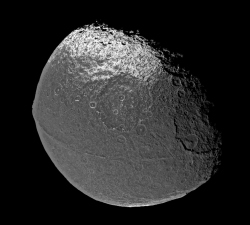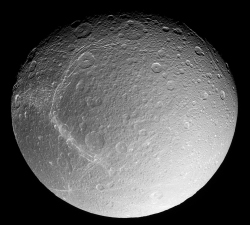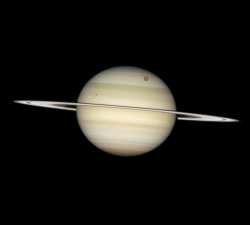Cassini Scientist for a day competition 2013 – targets
Which of these three targets would you choose?
To enter the competition, students should study each of the three targets that Cassini will image and decide which one they think will yield the best science results. A brief description of each of the targets is given below, along with links to further information.
 |
| Iapetus. Credit: NASA/JPL/Space Science Institute |
Iapetus was discovered in 1671 by Giovanni Cassini. This moon of Saturn is 1471 km in diameter and shaped a bit like a walnut with a ridge of very high mountains running around its equator. It has a fairly low density, just 1.2 times the density of liquid water. Perhaps three quarters of Iapetus is made up of ice and just one quarter rock.
As Iapetus orbits Saturn, it rotates very slowly, just once in about 79 days. It is tidally locked to Saturn, as our Moon is to the Earth, meaning that is always has the same side facing Saturn
Half the surface of this mysterious world is as dark as coal and the other half is very white and bright. Why Iapetus has this appearance is not yet understood, but is perhaps due to it sweeping up material from another, more distant, dark moon, or maybe the dark material is spread out by ice volcanism.
To find out more about this target view the information on the 'Cassini Scientist for a Day' competition pages.
 |
| Dione. Credit: NASA/JPL/Space Science Institute |
Discovered in 1684 by Giovanni Cassini, Dione is a small moon with a diameter of 1123 km. Images of Dione taken by the Voyager spacecraft showed bright wispy lines that are fractures across the surface. These ‘wisps' have also been imaged by the Cassini spacecraft, showing them to be bright ice cliffs. These suggest that Dione may have had tectonic activity in the past.
New evidence from studies of this interesting moon shows that perhaps there is a liquid layer underneath its hard, battered surface.
The heavily-cratered surface of Dione bears the scars of impacts of large objects from Saturn's rings. It is thought that some of these impacts might have caused this moon to spin around by 180 degrees.
To find out more about this target view the information on the 'Cassini Scientist for a Day' competition pages.
 |
| Saturn with four of its moons. Credit: NASA, ESA and the Hubble Heritage Team (STScI/AURA) |
Saturn has been known since antiquity and is the second largest planet in the Solar System. Known as a gas giant, it is mostly made up of hydrogen and helium, and has no distinct boundary between its atmosphere and deeper layers of liquid and solid forms of these gases.
Saturn is famous for its rings. There is a system of seven concentric rings surrounding the planet. The rings are composed of many icy and rocky particles ranging in size from that of a grain of sugar to a house, each travelling in their own orbit.
The rings of Saturn have baffled astronomers since they were discovered by Galileo Galilei in 1610. The rings are constantly changing, and their structure and how they formed is still under investigation.
To find out more about this target view the information on the 'Cassini Scientist for a Day' competition pages.
